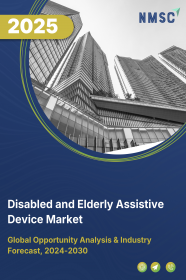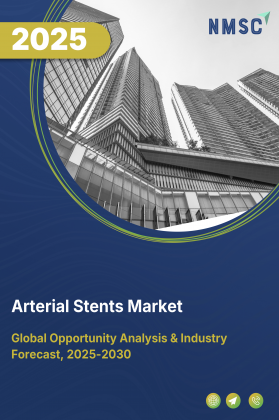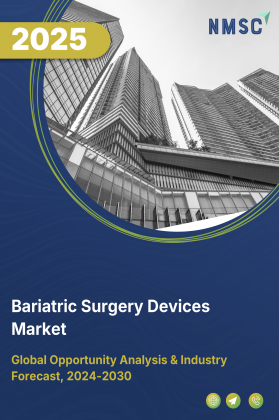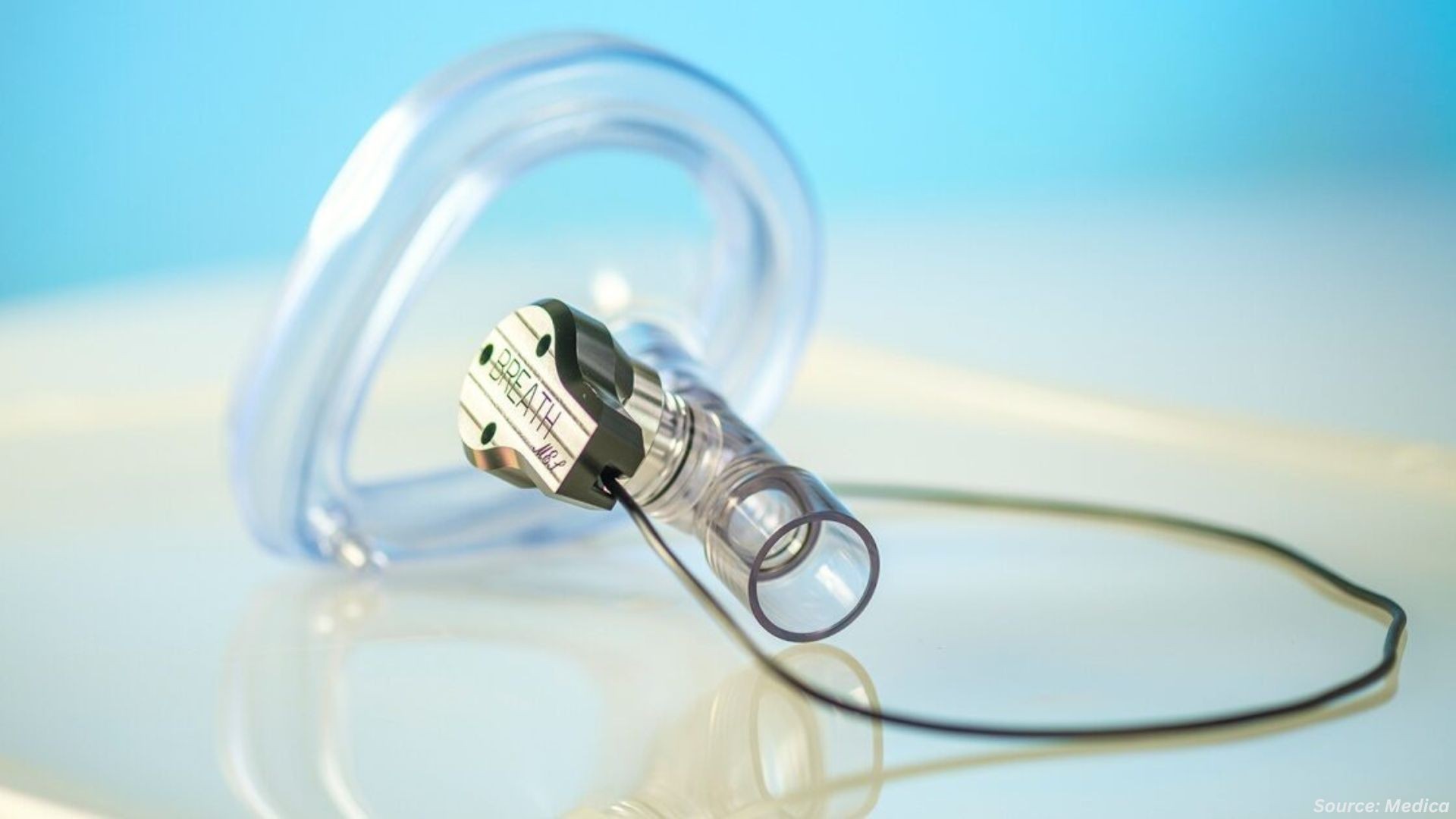
Disabled and Elderly Assistive Device Market by type (Mobility & Transfer Assistance, Hearing Impairments, Visual Impairments, Daily Living & Personal Care), by End-User (Home Care, Institutional Care, Community & Outpatient, Other) – Global Opportunity Analysis and Industry Forecast, 2025–2030
Industry: Healthcare | Publish Date: 29-Aug-2025 | No of Pages: 449 | No. of Tables: 304 | No. of Figures: 249 | Format: PDF | Report Code : HC71
Industry Overview
The global Disabled and Elderly Assistive Device Market size was valued at USD 33.74 billion in 2024, and is expected to be valued at USD 39.52 billion by the end of 2025. The industry is projected to grow further, hitting USD 70.05 billion by 2030, with a CAGR of 12.1% between 2025 and 2030.
The disabled and elderly assistive device market is expanding steadily, driven by the growing aging population, rising disability rates, and increased focus on independent living. The market is shaped by a combination of demographic shifts, technological progress, and supportive policy frameworks that collectively foster the adoption of assistive tools.
As mobility, sensory, and cognitive impairments become more prevalent, the need for reliable and accessible support solutions is gaining urgency. Innovations involving AI, IoT, and smart home integration are reshaping user experiences and making assistive products more intuitive and adaptable.
At the same time, governments across regions are adopting initiatives to make essential devices more affordable and available, especially in underserved areas. While high costs and uneven access remain key obstacles, the shift toward home-based care and personalized devices is opening up fresh opportunities. With mobility impairments accounting for a major share of demand and home care emerging as the preferred end-use segment, the market continues to evolve rapidly. Regional dynamics show Europe as a leading hub backed by a mature infrastructure, while Asia-Pacific records the fastest growth, supported by innovation and rising local production.
Aging Population and Increasing Disability Rates Driving Market Demand
The growing elderly population is a key driver for the expansion of the market. As individuals age, they face mobility, sensory, and cognitive challenges, increasing the demand for supportive devices. The global population aged 60 and above is projected to rise from 1.1 billion in 2023 to 1.4 billion by 2030, with life expectancy expected to reach 73.3 years in 2024, according to the World Health Organization (WHO).
Additionally, 1.3 billion people currently live with significant disabilities, a number rising due to age-related conditions and chronic illnesses like arthritis and dementia. This demographic shift, especially in regions like Asia Pacific and North America, fuels the need for technologies such as wheelchairs, walkers, and hearing aids to enhance independence and quality of life, driving continuous growth in the market.
Technological Innovations Transforming Assistive Solutions and Driving Market Growth
Technological advancements are propelling the disabled and elderly assistive device market growth, introducing smarter and more personalized solutions. For instance, in 2024, AI-powered smart glasses from companies such as AT Today and others are being introduced to enhance user-device interaction for individuals with physical impairments.
These glasses utilize AI to aid in tasks like navigation, object recognition, and text reading, promoting greater accessibility and independence. Similarly, in September 2024, the MIT Media Lab emphasized AI’s role in supporting independent living through smart home integration and wearable health monitors.
Moreover, companies are focusing on affordability, as demonstrated by Neomotion’s cost-effective wheelchairs, launched by an IIT Madras alumni startup in India in 2024. Innovations like brain-computer interfaces and IoT-based devices, such as JubileeTV’s communication hub, are also improving caregiver support and accessibility for the elderly.
In addition, exoskeletons and robotic assistance devices introduced in 2024 are aiding mobility and daily tasks. These technological innovations, including AI-powered devices, cost-effective solutions, and advancements in robotics, are improving the functionality and accessibility of assistive devices, fostering a more inclusive and empowered environment for the elderly and disabled. As these developments continue, they are set to drive further growth in the market, offering users greater independence and enhanced quality of life.
Government Initiatives Enhancing Accessibility and Propelling the Expansion of the Market
Supportive government initiatives are playing a vital role in the growth of the disabled and elderly assistive devices market by increasing accessibility and affordability. For example, in 2025, India's Department of Empowerment of Persons with Disabilities (DEPwD) introduced PM Divyasha Kendras, which streamline access to essential devices like wheelchairs and hearing aids through the ADIP scheme. Similarly, Singapore's Enabling Village, through its community-based labs established in 2024, is encouraging older adults to adopt assistive technologies.
In Australia, the ARIIA's 2024 initiative promotes access to these devices through equipment loan programs. On a global scale, the WHO's GATE Summit, scheduled for 2025, is set to accelerate the distribution of assistive technologies worldwide, while UNICEF is supporting device availability in countries like Laos. These government-driven initiatives are crucial in expanding the global market for assistive devices, fostering greater inclusivity and ensuring that individuals with disabilities and the elderly have access to the support they need, thereby driving market development and enhancing global accessibility.
High Costs and Limited Access Restrict Market Growth
The high cost of advanced assistive technologies remains a significant barrier in the disabled and elderly assistive devices market, particularly in developing regions. Enhanced devices, such as powered mobility aids or smart wearables, are often unaffordable for low-income populations.
Limited access to basic equipment like wheelchairs in rural areas, along with weak distribution networks and a lack of maintenance services, further restricts availability. Additionally, the absence of clear reimbursement policies in many countries makes it difficult for users to recover costs, hindering market growth and limiting access for those who need it most.
Integration of Advanced Technologies into Assistive Devices Creates Opportunity for The Market
The growing adoption of IoT and connected technologies is creating significant opportunities for the market. For example, in 2024, Jubilee TV launched a TV-based communication hub that enhances caregiver interaction and improves in-home accessibility for seniors, helping to reduce isolation.
This system allows seniors to make video calls, share family photos, set reminders, and control the TV remotely, offering valuable support for both elderly and disabled users. Such innovations are expanding the market by addressing the diverse needs of individuals with mobility, vision, and communication challenges.
As healthcare shifts toward home-based care and personalized support for aging populations, the demand for connected and user-friendly assistive devices is expected to grow, driving market advancements and broadening the reach of assistive technologies.
By Type, Mobility Impairments Hold the Dominant Share in the Assistive Device Market
Mobility impairments hold the largest share of the assistive device market, accounting for around 58.0%. These devices are crucial for individuals facing mobility challenges due to aging, physical disabilities, or chronic conditions. The range of mobility aids includes manual and powered wheelchairs, walking frames, crutches, and advanced robotic exoskeletons.
According to the World Health Organization (WHO), assistive products not only enhance mobility but also promote independence, reduce caregiver burden, and increase participation in daily activities. With an aging global population and a rise in noncommunicable diseases, an estimated 3.5 billion people will require assistive technology by 2050.
However, only one in 10 individuals currently have access due to high costs, limited awareness, and inadequate services in low-resource settings. This underscores the growing demand for affordable and adaptable solutions. The segment is further driven by innovations such as AI-powered assistive systems and customizable devices that enhance functionality and user comfort.
By End User, Home Care holds Dominant Share Along with the Highest CAGR
Home care dominates the market share and exhibits the highest growth rate in assistive device due to its ability to provide personalized and effective solutions that cater specifically to the needs of individuals in their homes. These personalized devices are reshaping caregiving by providing a variety of tools designed specifically for home environments.
These home care assistive devices empower individuals to live confidently and comfortably in their familiar homes, promoting dignity and self-sufficiency. For instance, in January 2024, Munevo launched a smart wheelchair, Munevo Drive that uses head gestures empower individuals with severe muscle diseases. This device aims to enhance mobility and to provide support to the disabled individuals.
Europe Holds the Dominating Share in the Global Disabled & Elderly Assistive Device Industry
Europe dominates the global disabled and elderly assistive device market share, driven by its aging population and increasing disability rates. The demand for assistive solutions is rising, with the UK’s population aged 65–79 expected to exceed 10 million in the next 40 years, making up nearly 30% of the total population, according to the Centre for Ageing Better’s 2023 report.
Similarly, France’s over-85 population is projected to grow from 1.4 million in 2023 to 5 million by 2060, as reported by the Fondation de France. These demographic changes underscore the need for mobility aids, sensory devices, and smart home technologies.
Additionally, Europe has experienced 25 years of steady growth in assistive technology adoption, supported by programs such as equipment loan schemes for wheelchairs and hearing aids, as noted by the Aged Care Research & Industry Innovation Australia (ARIIA). These factors position Europe to maintain its market leadership.
Furthermore, technological advancements are playing a vital role in driving the growth of the disabled and elderly assistive device market demand in Europe. For example, in 2024, Sunrise Medical launched the Allstar A2, a fully adjustable, multi-sport wheelchair designed to enhance user independence with customizable features. AI-powered smart glasses introduced in the UK also offer enhanced control for disabled individuals, illustrating how innovation is making assistive devices more accessible.
The integration of robotics and AI in elderly rehabilitation, highlighted in Nature’s 2024 publication, reinforces Europe's leadership in assistive technology. Technological progress, backed by major European players like Sunrise Medical, Ottobock, and Invacare, as well as the European Union’s focus on accessibility standards and inclusive design, is significantly contributing to market growth. Europe’s strong commitment to advancing assistive technologies is directly fueling market expansion, ensuring wider adoption and better accessibility across the region.
Asia-Pacific Region Witnesses Fastest Growth in the Disabled and Elderly Assistive Device Sector
The Asia-Pacific region is witnessing the fastest growth in the market, driven by a rapidly aging population, innovative developments, and strong government support aimed at enhancing accessibility.
In 2024, Indian startup Neomotion, founded by IIT Madras alumni, launched affordable and customizable wheelchairs, positioning India as a key player in assistive device manufacturing, as highlighted by The Indian Express and The CSR Universe.
Furthermore, the Indian government’s introduction of PM Divyasha Kendras under the ADIP scheme in 2025, aimed at streamlining access to mobility devices and hearing aids, is further bolstering the market, according to PIB India.
Moreover, in Singapore, the establishment of community-based labs by Enabling Village in 2024 has promoted assistive technology adoption among seniors, as reported by GovInsider Asia. Hyundai Motor India’s Samarth Assistive Devices Conclave in 2024 underscored the importance of inclusive product development, fostering industry growth.
While challenges like affordability and access persist in rural areas, as noted by UNICEF’s 2024 initiatives in Laos, the growing use of AI-powered aids, IoT-integrated solutions, and cost-effective designs is driving adoption across the region. These innovations and initiatives are contributing significantly to the growth of the disabled and elderly assistive device market trends, making it more accessible and sustainable across the Asia-Pacific region.
Innovation and Strategic Expansion Define the Competitive Landscape of the Market
The industry remains highly competitive, with several global players leading the way through technological advancements, strategic partnerships, and regional expansion. Companies like Sonova Holding AG, Demant A/S, WS Audiology A/S, MED‑EL Medical Electronics GmbHl, Ottobock SE & Co. KGaA Ossur hf., Arjo AB (publ), Drive DeVilbiss Healthcare, Inc., Sunrise Medical, LLC Savaria Corporation, Pride Mobility Products Corporation, Permobil AB, GF Health Products, Inc., Etac AB, and Meyra GmbH are driving the market forward with a focus on smart technologies such as AI, IoT, and robotics.
For instance, in June 2024, Ottobock UK launched the Juvo B7, an innovative powered wheelchair designed to support users with complex positioning and mobility needs, enhancing comfort and independence. In the hearing aids segment, companies like Demant and Sonova continue to dominate in Europe and North America, offering premium devices with advanced sound processing technologies.
In June 2024, WS Audiology further strengthened its presence by establishing an Audiological Research Laboratory in Singapore to foster innovation in hearing healthcare and improve hearing aid solutions.
Meanwhile, Starkey Hearing Technologies introduced its Genesis AI hearing aids in February 2024 in India, leveraging AI to provide personalized auditory assistance, marking a significant expansion into the growing APAC market.
GN Store Nord A/S also made strides in May 2024, launching the Enhance Select 500 hearing aid through its subsidiary Jabra, featuring Bluetooth LE Audio and SoundScape technology to improve speech clarity for elderly users. MED-EL made a strategic move in June 2024 by partnering with Microsoft to develop advanced accessibility tools for individuals with hearing loss, strengthening its position in the communication aids market.
In May 2024, Invacare launched the Alber DuoDrive Power Assist System, a groundbreaking addition to manual wheelchairs that integrates advanced power assistance, improving mobility for users.
Get the latest market share analysis and in-depth disabled and elderly assistive device industry insights. Add to Cart Now
Disabled and Elderly Assistive Device Market Key Segments
By Type
-
Mobility & Transfer Assistance
-
Wheelchairs (manual, electric, specialty)
-
Walkers and Rollators
-
Canes and Walking Sticks
-
Crutches
-
Portable Ramps and lifts
-
Others
-
-
Hearing Impairments
-
Behind‑the‑ear & In‑the‑ear Hearing Aids
-
Assistive Listening (FM/DM) Systems
-
Deafblind communicators for hearing
-
-
Visual Impairments
-
Screen readers and magnifiers
-
Optical magnifiers
-
Smart glasses and wearables
-
Navigation aids
-
Braille writing equipment
-
Talking Devices
-
-
Daily Living & Personal Care
-
Bathroom safety equipment (grab bars, shower chairs)
-
Kitchen and dining aids
-
Bed and bedroom accessories
-
Personal hygiene devices
-
By End User
-
Home Care
-
Institutional Care
-
Hospitals & Clinics
-
Assisted‑Living & Nursing Homes
-
Rehabilitation & Day‑care Centers
-
-
Community & Outpatient
-
Other
By Region
-
North America
-
The U.S.
-
Canada
-
Mexico
-
-
Europe
-
The UK
-
Germany
-
France
-
Italy
-
Spain
-
Denmark
-
Finland
-
Netherlands
-
Norway
-
Russia
-
Sweden
-
Rest of Europe
-
-
Asia-Pacific
-
China
-
Japan
-
India
-
South Korea
-
Australia
-
Indonesia
-
Singapore
-
Taiwan
-
Thailand
-
Rest of Asia-Pacific
-
-
Rest of World
-
Latin America
-
Middle East
-
Africa
-
Key Players
-
Sonova Holding AG
-
Demant A/S
-
WS Audiology A/S
-
MED‑EL Medical Electronics GmbH
-
Ottobock SE & Co. KGaA
-
Ossur hf.
-
Arjo AB (publ)
-
Drive DeVilbiss Healthcare, Inc.
-
Sunrise Medical, LLC
-
Savaria Corporation
-
Pride Mobility Products Corporation
-
Permobil AB
-
GF Health Products, Inc.
-
Etac AB
-
Meyra GmbH
REPORT SCOPE AND SEGMENTATION:
|
Parameters |
Details |
|
Market Size Value in 2024 |
USD 33.74 Billion |
|
Revenue Forecast in 2030 |
USD 70.05 Billion |
|
Value Growth Rate |
CAGR of 12.1% from 2025 to 2030 |
|
Analysis Period |
2024–2030 |
|
Base Year Considered |
2024 |
|
Forecast Period |
2025–2030 |
|
Market Size Estimation |
Billion (USD) |
|
Growth Factors |
|
|
Countries Covered |
28 |
|
Companies Profiled |
15 |
|
Market Share |
Available for 10 companies |
|
Customization Scope |
Free customization (equivalent up to 80 working hours of analysts) after purchase. Addition or alteration to country, regional, and segment scope. |
|
Pricing and Purchase Options |
Avail customized purchase options to meet your exact research needs. |

















 Speak to Our Analyst
Speak to Our Analyst

























